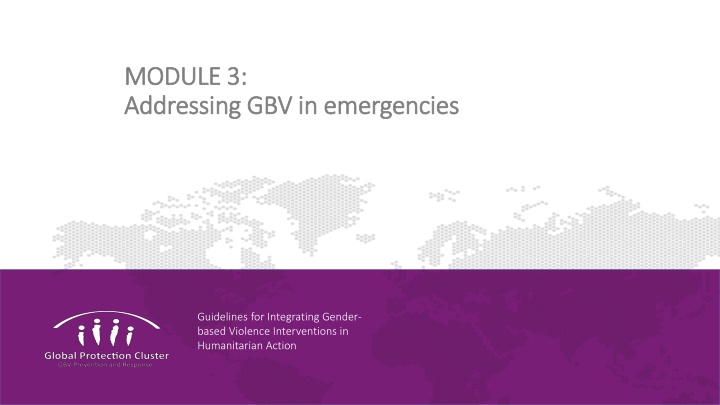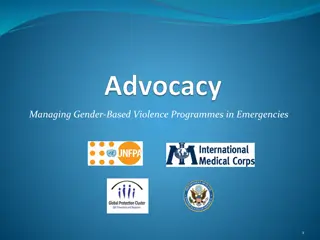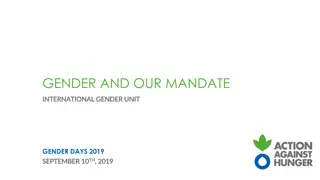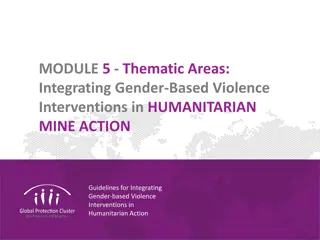Addressing Gender-Based Violence in Emergencies: Guidelines and Considerations
Addressing Gender-Based Violence in emergencies is crucial to protecting vulnerable groups from harm. This content provides guidelines for integrating interventions in humanitarian action, highlights the reasons for GBV occurrence, its exacerbation in emergencies, and the at-risk groups. It emphasizes the need to protect the rights of at-risk individuals and reduce their exposure to GBV and violence.
Download Presentation

Please find below an Image/Link to download the presentation.
The content on the website is provided AS IS for your information and personal use only. It may not be sold, licensed, or shared on other websites without obtaining consent from the author.If you encounter any issues during the download, it is possible that the publisher has removed the file from their server.
You are allowed to download the files provided on this website for personal or commercial use, subject to the condition that they are used lawfully. All files are the property of their respective owners.
The content on the website is provided AS IS for your information and personal use only. It may not be sold, licensed, or shared on other websites without obtaining consent from the author.
E N D
Presentation Transcript
MODULE 3: MODULE 3: Addressing GBV in emergencies Addressing GBV in emergencies Guidelines for Integrating Gender- based Violence Interventions in Humanitarian Action
Activity: GBV Risks Across the Stages of an Emergency Guidelines for Integrating Gender-based Violence Interventions in Humanitarian Action
Why Does GBViE Occur? Pre-existing - exists independent of, or prior to emergency or conflict *Emergency-related - specific to/resulting from the disaster or conflict *Humanitarian-related - caused directly or indirectly by humanitarian environment Guidelines for Integrating Gender-based Violence Interventions in Humanitarian Action
Why is GBV exacerbated in emergencies? New threats/forms of GBV related to conflict Lack of privacy; overcrowding; lack of safe access to basic needs Design of humanitarian aid heightens or introduces new GBV risks Separation from family members; lack of documentation; registration discrimination Break down of protective social mechanisms and norms regulating behaviour Increased vulnerability and dependence; exploitation Introduction of new power dynamics, as with humanitarian actors Guidelines for Integrating Gender-based Violence Interventions in Humanitarian Action
At-Risk Groups In an emergency there are groups that may be more vulnerable to harm than others These vulnerabilities may intersect What are some groups that are at particular risk of GBV where you work? Guidelines for Integrating Gender-based Violence Interventions in Humanitarian Action
Activity: At-Risk Groups Guidelines for Integrating Gender-based Violence Interventions in Humanitarian Action
Considerations for At-Risk Groups Protect the rights and needs of at-risk children Identify vulnerabilities such as age, disability, religion that intersect with gender-based discrimination and increase exposure to GBV Strive to reduce at-risk groups exposure to GBV and other forms of violence Recognize that at-risk groups may vary by setting What are some examples of how you reduce risk of violence for at-risk groups? Guidelines for Integrating Gender-based Violence Interventions in Humanitarian Action
Key Points Key Points - - context context GBV is rooted in gender and power inequalities that exist outside of conflict or disaster. However, there are particular ways that GBV can manifest in an emergency context. Efforts to reduce GBV in emergencies must therefore address the immediate needs of affected populations AND promote long-term social and cultural change toward gender equality
Reducing the burden of proof Reducing the burden of proof Always assume that GBV, in particular sexual violence, is occurring. Obtaining prevalence data isnot a priority at the onset of an emergency. Because ofunder-reporting and therisks associated with obtainingdata, the priority is to establish preventionand response measures as soon as possible.
GBV and (P)SEA: (Protection) Sexual Exploitation and Abuse (SEA) is an abuse of power power frequently based in gender and age inequality and discrimination abuse of The SG s Bulletin SG s Bulletin requires that all humanitarian personnel ensure action is taken to prevent SEA in their areas of operation, and report it when they observe any risks or abusive behavior. Protection from SEA should be linked with GBV programming especially to ensure survivors rights are respected; improve victim assistance and develop community-based complaints mechanisms (CBCMs). linked with GBV programming, SEA agency focal points should link with GBV actors to develop referral systems that support survivor-centered care and development of CBCMs. Guidelines for Integrating Gender-based Violence Interventions in Humanitarian Action
GBV and (P)SEA (contd): Ultimate accountability accountability for PSEA lies with senior management (Country Representatives) and human resources (Heads of HR Departments) The GBV Guidelines fully support the mandate of the SG s Bulletin and provide recommendations within each thematic area on programming to mitigate SEA, including incorporating PSEA strategies into agency policies and community outreach Guidelines for Integrating Gender-based Violence Interventions in Humanitarian Action
I always hear you talk about GBV prevention & response. What does that mean? and what on earth is risk mitigation? Guidelines for Integrating Gender-based Violence Interventions in Humanitarian Action
MITIGATION RESPONSE PREVENTION What: reducing the risk of exposure to GBV What: interventions to address the consequences of GBV after it has happened What: interventions to prevent GBV from first occurring How: address contributing factors How: address root causes How: through specialized services Examples? Examples? Examples? Who: ALL humanitarian actors, governments, communities .every one! Who: ALL humanitarian actors, governments, communities, everyone! Who: GBV, Health and Protection specialists, who have had appropriate training Guidelines for Integrating Gender-based Violence Interventions in Humanitarian Action
GBV MAINSTREAMING: all actors SPECIALIZED PROGRAMMING: specialists Avoid creating or exacerbating risks of GBV Reducing existing risks Understanding and linking to referral mechanisms for GBV survivors Applying core minimum standards into agency activities Direct service delivery Case management Psychosocial support Clinical care Legal support Economic reintegration Guidelines for Integrating Gender-based Violence Interventions in Humanitarian Action
Questions? Questions? Guidelines for Integrating Gender- based Violence Interventions in Humanitarian Action























